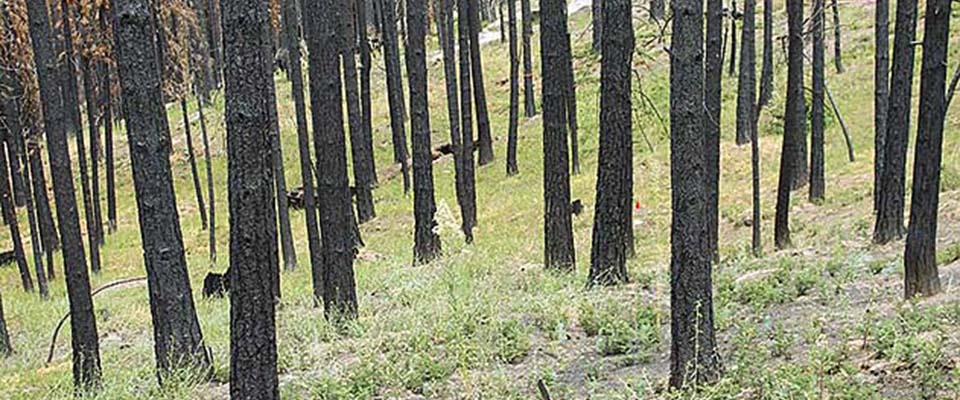As the U.S. Forest Service finalizes plans to restore forests torched in last year’s Yosemite-area Rim Fire—the third largest in state history—conservationists are worried that the scheme skimps on environmental protection. Also concerned is one of the state’s top forestry experts, a UC Berkeley professor who warns that replanting trees the traditional way will simply sow the seeds for the next conflagration.
Fire science professor Scott Stephens also contends that dallying by federal agencies is undermining a golden opportunity to fund wildland restoration by selling the young trees that must be thinned in Western forests.
“We don’t have that many options now, and drought and climate change will limit the options we do have the longer we wait,” Stephen says. “Our research shows that we could fund a lot of restoration right now if we get into the areas that are already replanted and market the young trees that must be thinned. We could increase the health of the forests, stimulate some economic activity for rural areas, cover a lot of our costs, and greatly reduce the vulnerability of our woodlands to fire. But we have to be proactive, we have to get going. What we do—or don’t do—right now will affect the Sierra Nevada for the next century or more.”
The Rim Fire burned more than 400 square miles of the Stanislaus National Forest and Yosemite National Park and caused $127 million in damage. Many forestry pundits consider it as a portent of the Sierra Nevada’s future; as climate change continues to desiccate the West, blazes like the Rim Fire could become the norm. In the year since the last embers of the Rim Fire were extinguished, calls for a change in western forest management have swelled.
Environmentalists’ main complaint with the Rim Fire restoration plan: Loggers would remove a lot of dead standing trees. The plan calls for logging about 15,000 acres of the 257,000 acres scorched by the blaze. But dead trees are highly valued by wildlife. Such “snags” provide living quarters and foraging sources for a wide array of creatures, including black-backed woodpeckers, a rare species in California. Too, snags return much needed nutrients to the soil when they eventually topple, increasing the general “resiliency” (a much-favored eco-term these days) of the forest.
Stephens, who is with Berkeley’s College of Natural Resources, shares some of those reservations about salvage logging. “I am concerned that some of salvage zone includes the Clavey River corridor, which is relatively small in area but is biologically rich and has lots of interesting things,” he says. “I’d like to see that area off-limits to logging. On the other hand, the plan calls for logging only a small percentage of the total burn area. And some of that is focused on removing snags along roads and highways, which I absolutely support. Roadside dead trees constitute a very real safety hazard.”
His primary concern is the Forest Service’s long-term plan for restoring the burn area. If it isn’t done right, he says, we risk a Rim Fire reprise.
“I’ve heard some things about possible planting methodologies (for the Rim Fire burn) that have made me nervous,” he said. “Apparently, forest managers are considering re-planting using the same old grid technique they’ve used in the past. That means planting one species of conifer—in the Sierra Nevada, that’s invariably ponderosa pine—on a dense grid of up to 300 trees an acre.”
That strategy essentially yields a tree plantation rather than a forest. Such conifer monocrops have little biodiversity because the habitat they provide is highly restricted: Only animals that favor expansive, dense stands of young conifers can thrive. A healthy forest has multiple tree species of different ages in a variety of configurations. This yields a wide array of habitats, from woodland meadows to old-growth groves. Historically, the Forest Service’s replanting strategies have not worked toward that end.
Even worse, says Stephens, is the vulnerability of such “grid forests” to wildfire. “A big problem is that the federal agencies get money for replanting, but very little for forest management. And without active thinning of these stands on an ongoing basis for 20 or 30 years, you end up with these uniform, heavy stands of trees that go up like a match. You essentially assure they will burn again.”
Critics of the plantation approach say the problem can be mitigated to a significant degree by changing planting strategies. Stephens favors a “clumpy” approach to restoration—eschewing the grid method and instead planting trees singly and in groups per a pattern that more closely mimics nature. Too, he says, managers should plant a variety of trees rather than relying simply on a single conifer such as ponderosa pine. Such replanted forests are relatively easy and cheap to manage through thinning and prescriptive burning.
“This approach already has been tried, and with considerable success, in the Plumas National Forest,” says Stephens. “The Forest Service allows a lot of autonomy to their district supervisors, so I don’t see why it should be a problem for (Stanislaus National Forest officials) as well.”
But Georgia Dempsey, a spokeswoman for the Forest Service’s Rim Fire recovery team, says no hard and fast decisions have yet been made on the restoration component of the Rim Fire plan.
“At this point it’s still in the R&D phase,” Dempsey says. She notes that the National Environmental Protection Act requires “a thorough process, and we’re now working through that, defining our palette of options. Our head silviculturalist, Marty Gmelin, is very forward-thinking. He knows what’s at stake, and he has been attending workshops in Sacramento to discuss possibilities with various stakeholders.”
The fact that forest managers are not immediately and reflexively jumping to a grid strategy for the Rim Fire restoration may be heartening, but Stephens emphasizes that time is of the essence.



















